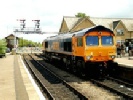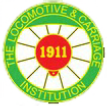Archive Section




Hard Lessons Learnt in a Railway Life
© Peter De Lacey
This article first appeared in the December 1998 Newsletter
A council meeting was hastily adjourned to allow Honorary Member Dick Hardy to deliver a keenly awaited presentation on his railway career.
A Conference room at 55 Broadway was fairly well filled for what turned out to be a fascinating insight into a career that spanned over forty years, from engineering apprentice in Doncaster to the B.R.B.. well, the clock beat that one. But of some consolation is that Mr. Hardy has agreed to return in May to continue his anecdotal history.
It all began with a childhood dream whilst at school when he was about 12. He fuelled this dream during school holidays, when he could be found on Amersham Station platform, watching the trains go by. Friendly signalmen would often invite him in to the signal box to see how the railway was operated first hand. The dream was further enhanced by being offered a cab ride on an A1 Pacific from Marylebone to Aylesbury on a night mail train.
Determined to enter railway employment, he went to Doncaster College of Technology before entering Doncaster Works as an Engineering Apprentice at 17. He was paid sixteen shillings and twopence for a fifty hour week and had to put up with Foremen who were worse than the Housemaster at school. He spent three years there, learning the trade. He realised that to progress, a degree would be required, so a school mate taught him the pure maths that was required to attain his HND. This study was done out of working hours, so by the time he had worked fifty hours, cleaned up outside that time, ate and slept there was not a lot of time left for study.
Whilst at Doncaster, he spent time with a fitter; in the running shop; on the Breakdown Gang and in the Locomotive drawing office to finish his apprenticeship.
On top of his working hours and study time, he would spend time travelling around the Doncaster area, observing the railway in operation and learning all the time. In 1941, whilst waiting at Wakefield for the mail to Doncaster, he was offered a footplate ride there by a crew he had seen previously. They took him under their collective wing and took it upon themselves to teach him the driver's trade. The crew had seen in Dick a future boss and wanted him to know the Fireman/Driver's trade.
During one of his footplate rides, from Bradford to Halifax, he had a S.P.A.D. whilst driving. The driver was not about to have this appear on his record so, whilst at Halifax, the three of them clubbed together and on the return trip, bribed the signalman not to report it.
After his apprenticeship, Dick went to be a Foreman at Shenfield under the wing of Mr. Parker, the shed master. In the Locomotive Inspectors' office, Mr. Parker trained him well, by getting him to think and question everything. Mr. Parker would get Dick to write letters for him, that he would then sign. If the letter was not exactly what Mr. Parker required, it would be returned to him without any explanation as to what was wrong. It was up to Dick to think it through and come up with the right answer. Sometimes letters would pass to and fro for weeks whilst Dick tried to read Mr. Parker's mind.
In 1946, Mr. Parker sent him to the Colchester area as Shed Master at King's Lynn. There he learnt the day shift, which involved rostering skills. Later he was left to
manage the shed between 12:00 and 15:00 each day. After making a mistake in scalling up' a passed fireman for a driving job, he learnt the correct procedure. After King's Lynn, he went to South Lynn shed and learnt industrial relations skills with a very good L.D.C. From there he spent a short time at Shenfield before moving briefly to Shed Master at Woodford, then onto the relief at Ipswich. There he locked horns with another good L.D.C. and had to come up with a way of improving morale among the crews. He did this by, amongst other things, allowing the crews to choose the colour of their locomotive's cab interior. Whilst this led to a sense of pride in the locomotive, it did not go unnoticed by those above.
Towards the end, we were eating out of his hand and, when he offered to stop for questions or carry on, the vote was overwhelmingly for him to continue. So this he did and finished with a rousing round of applause.
|
If you have enjoyed this article, you may also be interested in: |
|
|
By Richard Hardy - |
|